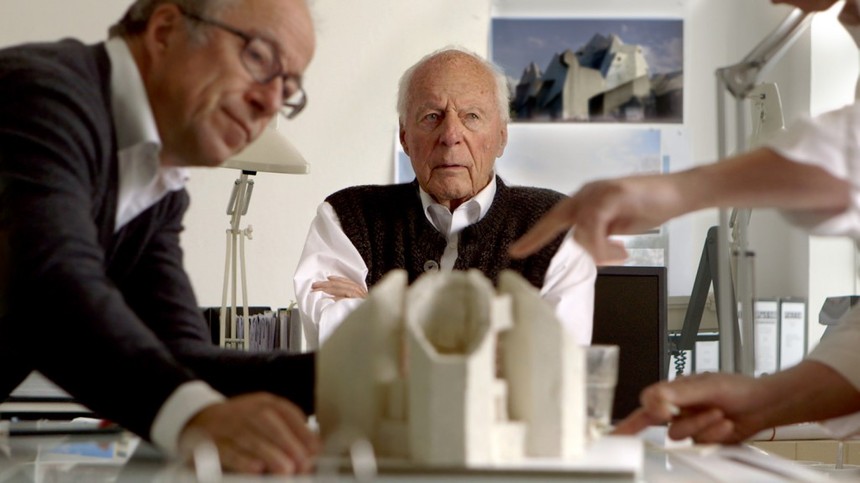Slamdance 2015 Review: CONCRETE LOVE, An Intimate, Immaculate Look At A Family Of Architects

We enter the Böhm's lives as matriarch Elisabeth falls ill. Her husband Gottfried, though by most accounts retired for years, continues to work diligently everyday on new designs with pencil and charcoal. He still lords over the work at the firm with his sons, Stefen, Peter and Paul. Models are made by hand in clay and plasticine. Small details, fine angles, are passionately defended by the father and his sons. When Gottfried sits in his home office sketching new wonders with an incredibly steady hand, Elisabeth catnaps in the background, occasionally getting up to chastise her husband on what he's come up with. We look upon a truly fantastic and sweeping design accented in red. This is work from the mind of a great imagineer, and she merely calls it "a pot".
Elisabeth and Gottfired's gentle arguing brings the film a life blood that is enduring. This tousled love that spurs the elderly couple on is greatly appreciated and felt by Staerkle-Drux, whose subtle, minimalist approach to merely wait and let a moment play brings us deeper into this fascinating family. With Elisabeth's passing the mood shifts to one of reflection and of sojourn. A light has gone out with Elisabeth, an inspiration for each of the Böhm men in their own ways. Stefen continues to focus on attaining work in the fast growing Chinese market, Peter gets ready for the opening of The Museum Of Egyptian Art, while Paul struggles with the controversy over the construction approach to a new mosque.
Meanwhile, Gottfried begins to get out of the house more, exploring his past architectural accomplishments across Germany: his great concrete churches, monuments for the ruins of World War II. As that goes his time as a soldier under the Nazi regime is still a great shadow for the man and his family, a collection of pacifists, whose desires lie in creation and faith, not destruction and hate. There is a healing and a honoring in Gottfried's work, which often literally extends on older structures, rather than just replacing them. This is something that is of concrete and steel, and also of the flesh and of the spirit. For in that valley where all coincide does something of heritage, of culture, and of change present itself. Architecture then is perhaps the greatest reflection of the human soul: abstract and practical in form and function.
Concrete Love achieves through its careful and caring detailing a sense of wonder for our modern world that few films achieve. The first time we enter the churches and community buildings Gottfried has built over the years, a flutter in the chest arises, tears swell up in the eyes. We are witness to something everlasting and of the moment. Or, take the opening scene: Gottfried sits in the gondola of a Ferris wheel, overlooking his city, the city of Colgone, smiling with astonishment and the satisfaction of achievement. It's the kind of wonder found only in very young boys and very old men. It's that knowing something both of the biggest picture and of the smallest.
As young of a filmmaker as Staerkle Drux is, he has crafted something that is masterful here, finding inspiration in his subjects and reflecting that back on his own work with a stern yet always curious eye. The film has a musical quality to it, washing over you like a chamber orchestra playing a stirring, quiet piece. It is deliberate and measured, guided by the nourishing rhythm of life itself.
As Gottfried reaches his 94th birthday, surrounded by his vast family, we are witness to a new wonder: the theater design from the beginning of the film, the roof a set of red waves overlapping. The work is completely different from the concrete designs he is so famous for. It is mercurial and reflective, flowing instead of grounding. With that we see Gottfried, the artist, ever amorphous, ever reborn, but remembering. Remembering Elisabeth, remembering how she always wore a red shawl, flowing behind her like water, as she shuffled down the stairs, he at her side.
So there you have these two people, hand in hand, entwined in a complex love: an immaculate design if there ever was one.

Do you feel this content is inappropriate or infringes upon your rights? Click here to report it, or see our DMCA policy.






